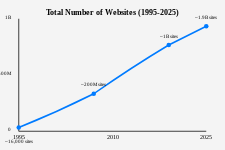One of the issues for our understanding of artificial intelligence is that we are so early in the process.
I think back to 1995 and the Alta Vista search engine, which I used for work, but which was not very useful, in large part because the number of indexed websites and pages was still low, and in part because the search architecture and user interface was not as "good" as Google search provided.
But the biggest problem was simply that if indexing of websites is a proxy for access to the sum total of human knowledge, there simply wasn't that much total knowledge available on websites. In 1995, for example, there were probably only about 16,000 websites in existence.
Compare that to the present, where more than two billion sites actually exist.
The point is that we are still quite early in development of generative AI, for example, and it is hard to envision where and how it will develop. In 1995 I could not have imagined what would be possible for search, for example.
One issue is that AI might take so many different forms.
One of the issues investors, entrepreneurs, end users and suppliers have to figure out about the various forms of artificial intelligence is “what is it?” In other words, using past computing analogies, AI might sometimes be akin to an operating system.
In other roles it might be more like a browser, a user interface, a platform or application or feature of an app.
So what it means can vary for various participants in the value chain. For suppliers of computing capabilities, AI “as OS” could mean creation of a new computing ecosystem and paradigm.
As a “browser” substitute, AI could change the way people search for information. As a UI, AI probably will change the way humans interact with computing machines.
As a “platform” AI could be the foundation for whole new categories of software and ecosystems built on specific platforms.
The least controversial analogy might be AI “as an app or feature,” since it will be integrated with most existing software and hardware in some way.
Analogy | Key Points | Implications |
Operating System | - Acts as a kernel process orchestrating other applications2 - Manages input/output across modalities - Controls code execution and browser access - Handles memory storage and retrieval | - AI could become the foundation of a new computing paradigm2 - May lead to more adaptive, customizable, and flexible systems |
Browser | - Can automate web-based tasks like research and shopping3 - Enables AI to interact directly with web content - Allows for autonomous browsing and information retrieval | - Could revolutionize how we interact with online information and services - May lead to more efficient and personalized web experiences |
User Interface | - Understands and generates multiple modalities (text, audio, vision)2 - Can replace traditional GUI-based interfaces - Enables natural language interaction | - Could make computing more accessible and intuitive - May lead to new forms of human-computer interaction |
Platform | - Serves as a foundation for running AI models and applications2 - Manages AI-specific workloads - Integrates AI capabilities across various services | - Could become the basis for future software development - May lead to widespread AI integration in all digital services |
App/Feature | - Enhances existing applications with AI capabilities3 - Automates specific tasks within larger systems - Improves user experience in targeted areas | - Could lead to incremental improvements in existing software - May result in more intelligent and responsive applications |


No comments:
Post a Comment